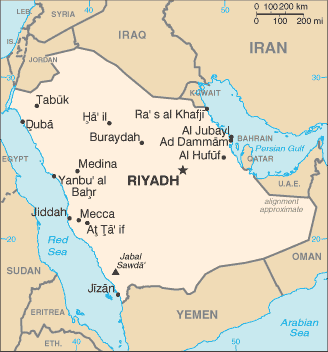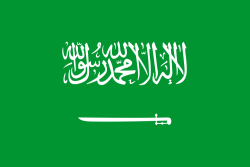Kingdom of Saudi Arabia
Related Categories:
 Explore Saudi Arabia
Explore Saudi ArabiaNational symbols – the flag, the emblem and the national anthem. Fun and informative educational website for students of all ages.
www.exploresaudiarabia.com/
The letter "X" soon may be banned in Saudi Arabia because it resembles the mother of all banned religious symbols in the oil kingdom: the cross.
www.nysun.com/
The inclusion of sacred Islamic Text on the flag of Saudi Arabia has created problems when the flag is reproduced on souvenir items or as a throw-away handwaver.
www.fotw.us/
The Kingdom is sometimes called "The Land of The Two Holy Mosques" in reference to Mecca and Medina, the two holiest places in Islam.
en.wikipedia.org/
Saudi Arabia's 2005 population was estimated to be about 27 million, including about 5.6million resident foreigners. Until the 1960s, most of the population was nomadic or seminomadic; due to rapid economic and urban growth, more than 95% of the population now is settled. Some cities and oases have densities of more than 1,000 people per square kilometer (2,600 per sq. mi).
Saudi Arabia is known as the birthplace of Islam, which in the century following Muhammad's death in 632 A.D. spread west to Spain and east to India. Islam obliges all Muslims to make the Hajj, or pilgrimage to Makkah, at least once during their lifetime if they are able to do so. The cultural environment in Saudi Arabia is highly conservative; the country adheres to a strict interpretation of Islamic religious law (Shari'a). Cultural presentations must conform to narrowly defined standards of ethics. Men and women are not permitted to attend public events together and are segregated in the work place.
Most Saudis are ethnically Arab. Some are of mixed ethnic origin and are descended from Turks, Iranians, Indonesians, Indians, Africans, and others, most of whom immigrated as pilgrims and reside in the Hijaz region along the Red Sea coast. Many Arabs from nearby countries are employed in the kingdom. There also are significant numbers of Asian expatriates mostly from India, Pakistan, Bangladesh, Indonesia, and the Philippines. There are less than 100,000 Westerners in Saudi Arabia.
www.state.gov/r/
Introduction
About
Contact
Symbols in The News
Interpret this Symbol
AAC
African
AI
Alchemy
Alphabets
Ancient
Animal Symbolism
Architecture
Art
Articles
Astrology
Baha'i
Blissymbolics
Blueprint Symbols
Buddhist
Celtic Symbols
Cemetery
Chinese Symbols
Christian
Circle
City
Codes
Color
Conlangs
Crop Circles
Danger
Da Vinci Code
Designing Logos
Dictionaries
Dreams
Education
Egyptian Symbols
Electrical
Emoticons
Find Images
Fonts
Food
Fraternity
Hamsa
Healing
Heraldry
Hermetic
Highway Signs
Hindu
History
Hobo
Holiday
Icons
iConji
Islamic
Jain Symbols
Japanese, Kanji
Jewish
Justice
Law
Literary Symbolism
Mandalas
Map
Masonic
Math, Number
Meaning of Names
Medical
Middle East
Military
Miscellaneous
Money
Music
Mythology
Native American
Playing Cards
Power
Psychology
QiQiiKhu
Reiki
Religious
Runes, Norse
Sacred Geometry
Scientific
Science Fiction
Sorority
Sports
Symbols in the News
Tattoos
ThirteenSymbols
Tree of Life
Ursprache
Videos
Visual Languages
Weather
Web Codes
Wicca
Words
Writing Systems
Braille
Coinherence
Coptic
Cuneiform
Easter Island
Etruscan
Happy Human
Hebrew
Kokopelli
Linear B
Lotus
Love Symbols
Mandorla
Moon Alphabet
Nine Pointed Star
Om
Oz
Phonetic
Scarab Beetle
Silent
Theosophy
Unifon
About
Contact
Symbols in The News
Interpret this Symbol
AAC
African
AI
Alchemy
Alphabets
Ancient
Animal Symbolism
Architecture
Art
Articles
Astrology
Baha'i
Blissymbolics
Blueprint Symbols
Buddhist
Celtic Symbols
Cemetery
Chinese Symbols
Christian
Circle
City
Codes
Color
Conlangs
Crop Circles
Danger
Da Vinci Code
Designing Logos
Dictionaries
Dreams
Education
Egyptian Symbols
Electrical
Emoticons
Find Images
Fonts
Food
Fraternity
Hamsa
Healing
Heraldry
Hermetic
Highway Signs
Hindu
History
Hobo
Holiday
Icons
iConji
Islamic
Jain Symbols
Japanese, Kanji
Jewish
Justice
Law
Literary Symbolism
Mandalas
Map
Masonic
Math, Number
Meaning of Names
Medical
Middle East
Military
Miscellaneous
Money
Music
Mythology
Native American
Playing Cards
Power
Psychology
QiQiiKhu
Reiki
Religious
Runes, Norse
Sacred Geometry
Scientific
Science Fiction
Sorority
Sports
Symbols in the News
Tattoos
ThirteenSymbols
Tree of Life
Ursprache
Videos
Visual Languages
Weather
Web Codes
Wicca
Words
Writing Systems
Braille
Coinherence
Coptic
Cuneiform
Easter Island
Etruscan
Happy Human
Hebrew
Kokopelli
Linear B
Lotus
Love Symbols
Mandorla
Moon Alphabet
Nine Pointed Star
Om
Oz
Phonetic
Scarab Beetle
Silent
Theosophy
Unifon

